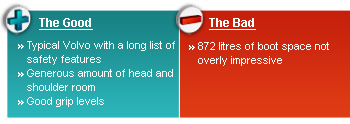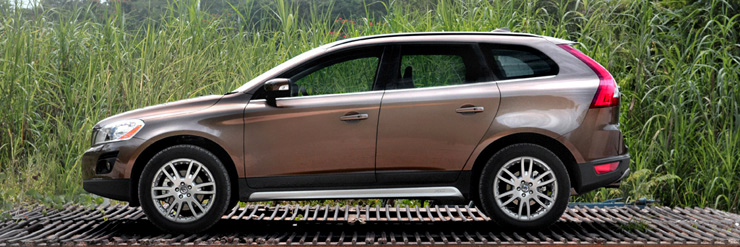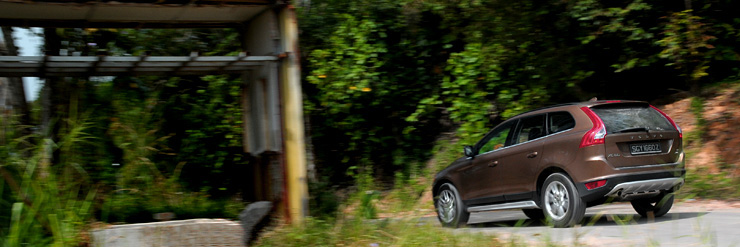Volvo XC60 T6 Review
05 Feb 2009|33,378 views
 |
Information is then relayed to a computer that calculates the necessary braking strength in order to avoid crashing no less than 50 times a second. If the driver fails to respond with the brakes out of a preset level of tolerances, the system assumes a car crash and automatically draws on the pre-charged brakes.
If the relative speed difference between the XC60 and the other vehicle is less than 15 km/h, a collision might be entirely avoidable. However, you might get away with just a scrape if the relative speed between the two lies between 15 km/h and 30 km/h.
And above those speeds, Volvo can't and won't be responsible for your actions.
As inventors of the three-point seatbelt and curtain airbag, you can't not mention a new Volvo and skip on its safety features, which are literally, an alphabetical soup of jargons. In addition to ACC (Adaptive Cruise Control), PA (Park Assist), and LDW (Lane Departure Warning), there are features, some optional, such as DAC (Driver Alert Control), DA (Distance Alert), BLIS (Blind Spot Information System), DTSC (Dynamic Traction Stability Control), RSC (Roll Stability Control), CWAB (Collision Warning with Auto Brake), WHIPS (Whiplash Protection System), and TSA (Towing Stability Assist).
They're all housed in Volvo's stiff new shell. Some of you might not be too surprised to know that the XC60 is partially related in chassis to Land Rover's Freelander, despite the 18 month delay.
But it's mostly minor. Everything from the front bulkhead, upper constitution, interior configuration and seating positions are independent from the aforementioned Ford C1+ platform, which is also what the V70 and S80 cars are based on.
 |
A little background on design
There's a key element or two that marks Volvo's new approach to product DNA. Where it was previously known as "Do Not Abandon," Volvo's Steve Mattin, Volvo Cars design director, explicitly stated that they have "now expanded its significance to redefine DNA as taking a "Dramatic New Approach."
These include a new wedge-shaped front grille similar to Ford's Kuga. The Volvo badge is larger, and is embedded in the grille instead of a square box. New swept-back headlights shape and emphasise the bonnet's menacing V-shape as well as a low to high beltline that meets the car's boot-line at the rear. Here, the traditional, vertically stacked tail-light cluster is further shaped to follow the flare of the car's shoulders in a beautiful curve.
At 4,628 mm long, the XC60 is 211 mm shorter than the XC70 but is in the league of other two-row, five-passenger premium compacts like the BMW X3. An impressive 231 mm of ground clearance also mean that it is ready for much more dirt than you might expect. This class leading figure also puts it ahead of many larger, ladder-framed SUVs like the wacky Toyota FJ Cruiser sold in Europe.
Pity that it did not come with higher profile tyres and full time, locking four wheel drive. Neither did it feature the concept's aggressive looking wheels, because even with 235/55 R19 Continental Cross Contacts, the XC60's wheel arches looked a little vacant. Well then, this should give you an idea of its beefy side profile.
Living space
Interior design is not dramatic but more "Ikea-ish", or smartly Scandinavian in implementation. Sorry, we couldn't resist. There were classic Volvo tell-tale signs everywhere. First was the elegant floating centre-console, and who could ignore the comfortable seats finished in soft leather that was accompanied by beautiful, brown-coloured stitching.
The metallic Terra Bronze Pearl paint went down well with a combination of panel textures and large-grain, dark-grey vinyl on the doors, dashboard, and seats.
Rear seat, head and legroom was definitely on the generous side when compared to all of its competitors. The flipside might have been the lack of cargo space - 872 litres with all seats up. But this grew to a flat and useful 1,909 litres with the 40/20/40 rear benches folded down.
Also typical of Volvo was the superb driving position. Combined with a tilt-reach adjustable wheel, it was high enough to satisfy the shortest and edgiest of women drivers. In addition, it was well low enough for me to feel cocooned and comfortable over longer distances.
 |
Driving impressions
Currently, the XC60 only sells in T6 form, which means a transversely-mounted 2,953 cc, turbocharged 24-valve inline-six engine outputting 285 bhp at 5,600 rpm. A six-speed Aisin "Geartronic" transmission with manual-shift option links it to the all-wheel, "Instant Traction" drivetrain.
The Haldex Gen IV-equipped all-wheel drive, under normal driving conditions, is front-biased. Normally, it sends 90-percent of torque to the front wheels and apportions up to 65 percent to the rear wheels in sticky situations of limited traction. That hardly sounds as sporty as Volvo wants the XC60 T6 to be, but it still launches of the line.
We put Volvo's 7.1 second claim to the stopwatch and found that the 1,900-odd kilogramme five-seater does 0-100 km/h in just 0.4 seconds slower on a hot afternoon. Our butt dynos told us it was much slower than that, but the deceptive element was the car's high level of comfort and insulation.
The T6's 400 Nm might not be as thrusting as what its figures claim, which is from 1,500 to 4,800 rpm. The Volvo realises that it's supposed to be erupting torque when approaching the 3,000 rpm mark, making acceleration and overtaking in any gear as brainless as one can imagine, as long as the revs are held in sport mode or when shifting the gears yourself.
Sixth gear, while not managing to be a huge jump from fifth, is sufficiently tall, with 80 km/h seeing the engine tick over at just 1,500 rpm. Acceleration in third from 60 km/h to 100 km/h took only five seconds. The throttle responded eagerly when prodded, and delivered a pleasant, fearsome growl that was somewhat muted by the thick firewall.
Wind noise started to intrude rather early on at straight-line cruising speeds of around 100 km/h. However, its volume never really increased when the car was pushed to much higher speeds.
 |
But what surprised us the most was the Volvo's poise through corners. It was much firmer to drive than any other Volvo, save for the sportily-oriented C30 and S60 T5. This came as a surprise considering the V70 and S80 T6's "softer" leanings.
Body roll was absent and front-end grip was high for a car its size and height. We wouldn't call it a neutral handler, but it sure out-lasted any smaller, sports-oriented SUV that we've sampled. The XC60 handles almost as well as the BMW X3 and X5, save for small amounts of steering feedback and softer-sprung underpinnings. That's high praise for Volvo, mind you.
And when it comes to fitting in™
With the absence of other petrol-engined variants in the line-up, we predict the car's appeal to be amongst a more affluent, urban customer base looking for something safe for his or her family. The XC60 exudes a premium level of quality expected from it, and gives buyers enough style to warrant serious competition against the German three.
For a price of S$160,988, one would have to dig a little deeper (Land Rover Freelander 2 at S$165,888 or BMW X3 for S$168,000), or a lot deeper (Mercedes ML350 at S$225,888) so as to play to the tune of compact SUVs at similar standards. Not to mention that all of them aren't as quick.
But does it have its place? I'd like to think of the Volvo XC60 as a piece of classical music titled "Variations on a theme of Paganini." Once a humble, novel piece, many composers have picked up on the 30 second long tune. They've added to it clever little elements from experience gained with their past successes amongst audiences worldwide that when combined, form the basis of a giant, improvised workhorse spanning the length of 15 minutes. Today, the Paganini-variations are world-renowned rhapsodies found in the stable of many composers such as Sergei Rachmaninoff, the Russian virtuoso-composer.
We've all seen compact SUVs and they're all the rage right now; from entry-level, budget-like offerings such as the Daihatsu Terios to the upper-east side BMW. But arguably, we've not seen anyone do the urban rendition better. It has done well drawing from past experiences in design, execution and it shows in the overall finished product. We even think that it's increased its appeal to the younger buying crowd.
Most importantly, the Volvo XC60 is the critical piece that showcases how Volvo will transform the rest of its range in due time.
 |
Information is then relayed to a computer that calculates the necessary braking strength in order to avoid crashing no less than 50 times a second. If the driver fails to respond with the brakes out of a preset level of tolerances, the system assumes a car crash and automatically draws on the pre-charged brakes.
If the relative speed difference between the XC60 and the other vehicle is less than 15 km/h, a collision might be entirely avoidable. However, you might get away with just a scrape if the relative speed between the two lies between 15 km/h and 30 km/h.
And above those speeds, Volvo can't and won't be responsible for your actions.
As inventors of the three-point seatbelt and curtain airbag, you can't not mention a new Volvo and skip on its safety features, which are literally, an alphabetical soup of jargons. In addition to ACC (Adaptive Cruise Control), PA (Park Assist), and LDW (Lane Departure Warning), there are features, some optional, such as DAC (Driver Alert Control), DA (Distance Alert), BLIS (Blind Spot Information System), DTSC (Dynamic Traction Stability Control), RSC (Roll Stability Control), CWAB (Collision Warning with Auto Brake), WHIPS (Whiplash Protection System), and TSA (Towing Stability Assist).
They're all housed in Volvo's stiff new shell. Some of you might not be too surprised to know that the XC60 is partially related in chassis to Land Rover's Freelander, despite the 18 month delay.
But it's mostly minor. Everything from the front bulkhead, upper constitution, interior configuration and seating positions are independent from the aforementioned Ford C1+ platform, which is also what the V70 and S80 cars are based on.
 |
A little background on design
There's a key element or two that marks Volvo's new approach to product DNA. Where it was previously known as "Do Not Abandon," Volvo's Steve Mattin, Volvo Cars design director, explicitly stated that they have "now expanded its significance to redefine DNA as taking a "Dramatic New Approach."
These include a new wedge-shaped front grille similar to Ford's Kuga. The Volvo badge is larger, and is embedded in the grille instead of a square box. New swept-back headlights shape and emphasise the bonnet's menacing V-shape as well as a low to high beltline that meets the car's boot-line at the rear. Here, the traditional, vertically stacked tail-light cluster is further shaped to follow the flare of the car's shoulders in a beautiful curve.
At 4,628 mm long, the XC60 is 211 mm shorter than the XC70 but is in the league of other two-row, five-passenger premium compacts like the BMW X3. An impressive 231 mm of ground clearance also mean that it is ready for much more dirt than you might expect. This class leading figure also puts it ahead of many larger, ladder-framed SUVs like the wacky Toyota FJ Cruiser sold in Europe.
Pity that it did not come with higher profile tyres and full time, locking four wheel drive. Neither did it feature the concept's aggressive looking wheels, because even with 235/55 R19 Continental Cross Contacts, the XC60's wheel arches looked a little vacant. Well then, this should give you an idea of its beefy side profile.
Living space
Interior design is not dramatic but more "Ikea-ish", or smartly Scandinavian in implementation. Sorry, we couldn't resist. There were classic Volvo tell-tale signs everywhere. First was the elegant floating centre-console, and who could ignore the comfortable seats finished in soft leather that was accompanied by beautiful, brown-coloured stitching.
The metallic Terra Bronze Pearl paint went down well with a combination of panel textures and large-grain, dark-grey vinyl on the doors, dashboard, and seats.
Rear seat, head and legroom was definitely on the generous side when compared to all of its competitors. The flipside might have been the lack of cargo space - 872 litres with all seats up. But this grew to a flat and useful 1,909 litres with the 40/20/40 rear benches folded down.
Also typical of Volvo was the superb driving position. Combined with a tilt-reach adjustable wheel, it was high enough to satisfy the shortest and edgiest of women drivers. In addition, it was well low enough for me to feel cocooned and comfortable over longer distances.
 |
Driving impressions
Currently, the XC60 only sells in T6 form, which means a transversely-mounted 2,953 cc, turbocharged 24-valve inline-six engine outputting 285 bhp at 5,600 rpm. A six-speed Aisin "Geartronic" transmission with manual-shift option links it to the all-wheel, "Instant Traction" drivetrain.
The Haldex Gen IV-equipped all-wheel drive, under normal driving conditions, is front-biased. Normally, it sends 90-percent of torque to the front wheels and apportions up to 65 percent to the rear wheels in sticky situations of limited traction. That hardly sounds as sporty as Volvo wants the XC60 T6 to be, but it still launches of the line.
We put Volvo's 7.1 second claim to the stopwatch and found that the 1,900-odd kilogramme five-seater does 0-100 km/h in just 0.4 seconds slower on a hot afternoon. Our butt dynos told us it was much slower than that, but the deceptive element was the car's high level of comfort and insulation.
The T6's 400 Nm might not be as thrusting as what its figures claim, which is from 1,500 to 4,800 rpm. The Volvo realises that it's supposed to be erupting torque when approaching the 3,000 rpm mark, making acceleration and overtaking in any gear as brainless as one can imagine, as long as the revs are held in sport mode or when shifting the gears yourself.
Sixth gear, while not managing to be a huge jump from fifth, is sufficiently tall, with 80 km/h seeing the engine tick over at just 1,500 rpm. Acceleration in third from 60 km/h to 100 km/h took only five seconds. The throttle responded eagerly when prodded, and delivered a pleasant, fearsome growl that was somewhat muted by the thick firewall.
Wind noise started to intrude rather early on at straight-line cruising speeds of around 100 km/h. However, its volume never really increased when the car was pushed to much higher speeds.
 |
But what surprised us the most was the Volvo's poise through corners. It was much firmer to drive than any other Volvo, save for the sportily-oriented C30 and S60 T5. This came as a surprise considering the V70 and S80 T6's "softer" leanings.
Body roll was absent and front-end grip was high for a car its size and height. We wouldn't call it a neutral handler, but it sure out-lasted any smaller, sports-oriented SUV that we've sampled. The XC60 handles almost as well as the BMW X3 and X5, save for small amounts of steering feedback and softer-sprung underpinnings. That's high praise for Volvo, mind you.
And when it comes to fitting in™
With the absence of other petrol-engined variants in the line-up, we predict the car's appeal to be amongst a more affluent, urban customer base looking for something safe for his or her family. The XC60 exudes a premium level of quality expected from it, and gives buyers enough style to warrant serious competition against the German three.
For a price of S$160,988, one would have to dig a little deeper (Land Rover Freelander 2 at S$165,888 or BMW X3 for S$168,000), or a lot deeper (Mercedes ML350 at S$225,888) so as to play to the tune of compact SUVs at similar standards. Not to mention that all of them aren't as quick.
But does it have its place? I'd like to think of the Volvo XC60 as a piece of classical music titled "Variations on a theme of Paganini." Once a humble, novel piece, many composers have picked up on the 30 second long tune. They've added to it clever little elements from experience gained with their past successes amongst audiences worldwide that when combined, form the basis of a giant, improvised workhorse spanning the length of 15 minutes. Today, the Paganini-variations are world-renowned rhapsodies found in the stable of many composers such as Sergei Rachmaninoff, the Russian virtuoso-composer.
We've all seen compact SUVs and they're all the rage right now; from entry-level, budget-like offerings such as the Daihatsu Terios to the upper-east side BMW. But arguably, we've not seen anyone do the urban rendition better. It has done well drawing from past experiences in design, execution and it shows in the overall finished product. We even think that it's increased its appeal to the younger buying crowd.
Most importantly, the Volvo XC60 is the critical piece that showcases how Volvo will transform the rest of its range in due time.
Car Information
Volvo XC60 T6 (A)
CAT B|Petrol|9.3km/L
Horsepower
227kW (304 bhp)
Torque
440 Nm
Acceleration
7.3sec (0-100km /hr)
This model is no longer being sold by local distributor
All Used Volvo XC60Thank You For Your Subscription.



















































